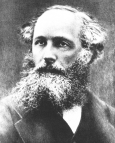 James Clerk Maxwell
James Clerk Maxwell James Clerk Maxwell
James Clerk MaxwellMaxwell's first major contribution to science was a study of the planet Saturn's rings, the nature of which was much debated. Maxwell showed that stability could be achieved only if the rings consisted of numerous small solid particles, an explanation still accepted. Maxwell next considered molecules of gases in rapid motion. By treating them statistically he was able to formulate (1866), independently of Ludwig Boltzmann, the Maxwell-Boltzmann kinetic theory of gases. This theory showed that temperatures and heat involved only molecular movement. Philosophically, this theory meant a change from a concept of certainty--heat viewed as flowing from hot to cold--to one of statistics--molecules at high temperature have only a high probability of moving toward those at low temperature. This new approach did not reject the earlier studies of thermodynamics; rather, it used a better theory of the basis of thermodynamics to explain these observations and experiments.
Maxwell's most important achievement was his extension and mathematical formulation of Michael Faraday's theories of electricity and magnetic lines of force. In his research, conducted between 1864 and 1873, Maxwell showed that a few relatively simple mathematical equations could express the behavior of electric and magnetic fields and their interrelated nature; that is, an oscillating electric charge produces an electromagnetic field. These four partial differential equations first appeared in fully developed form in Electricity and Magnetism (1873). Since known as Maxwell's equations they are one of the great achievements of 19th-century physics.
Maxwell also calculated that the speed of propagation of an electromagnetic field is approximately that of the speed of light. He proposed that the phenomenon of light is therefore an electromagnetic phenomenon. Because charges can oscillate with any frequency, Maxwell concluded that visible light forms only a small part of the entire spectrum of possible electromagnetic radiation.
Maxwell used the later-abandoned concept of the ether to explain that electromagnetic radiation did not involve action at a distance. He proposed that electromagnetic-radiation waves were carried by the ether and that magnetic lines of force were disturbances of the ether. Heinrich Hertz discovered such waves in 1888.
